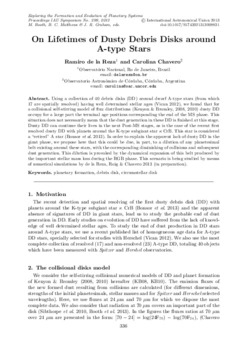| dc.creator | de la Reza, R. | es |
| dc.creator | Chavero, Carolina Andrea | es |
| dc.date.accessioned | 2021-07-07T21:05:11Z | |
| dc.date.available | 2021-07-07T21:05:11Z | |
| dc.date.issued | 2014-01 | |
| dc.identifier.isbn | 1743-9221 | |
| dc.identifier.issn | 1743-9221 | |
| dc.identifier.uri | http://hdl.handle.net/11086/18941 | |
| dc.description | Fil: Chavero, Carolina Andrea. Universidad Nacional de Córdoba. Observatorio Astronómico de Córdoba; Argentina. | es |
| dc.description | Abstract: Using a collection of 40 debris disks (DD) around dwarf A-type stars (from which 17 are spatially resolved) having well determined stellar ages (Vican 2012), we found that for a collisional self-stirring model of flux distributions (Kenyon & Bromley, 2008, 2010) dusty DD occupy for a large part the terminal age positions corresponding the end of the MS phase. This situation does not necessarily mean that the dust generation in these DD is finished at this stage. Dusty DD can continue their lives in the next Post-MS stages, as is the case of the recent first resolved dusty DD with planets around the K-type subgiant star Kappa CrB. This star is considered a ``retired´´ A star (Bonsor et al. 2013). In order to explain the apparent lack of dusty DD in the giant phase, we propose here that this could be due, in part, to a dilution of any planetesimal belt existing around these stars, with the corresponding diminishing of collisions and subsequent dust generation. This dilution is provoked by the dynamical expansion of this belt produced by the important stellar mass loss during the RGB phase. This scenario is being studied by means of numerical simulations by de la Reza, Roig & Chavero (in preparation). | en |
| dc.description.uri | http://journals.cambridge.org/download.php?file=%2FIAU%2FIAU8_S299%2FS1743921313008831a.pdf&code=1bb2a189da69df2d91802b67ab63f032 | |
| dc.format.medium | Impreso; Electrónico y/o Digital | |
| dc.language.iso | eng | es |
| dc.publisher | IAU Editorial | es |
| dc.rights | Attribution-NonCommercial-ShareAlike 4.0 International | * |
| dc.rights.uri | https://creativecommons.org/licenses/by-nc-sa/4.0/ | * |
| dc.subject | Planetary formation | es |
| dc.subject | Debris disk | es |
| dc.subject | Circumstellar disk | es |
| dc.subject | Circumstellar disks | es |
| dc.subject | Debris | es |
| dc.subject | Disks | es |
| dc.subject | Planetary | es |
| dc.subject | Formation | es |
| dc.title | On Lifetimes of Dusty Debris Disks around A-type Stars | es |
| dc.type | conferenceObject | es |
| dc.journal.referato | | |
| dc.description.field | Astronomía (incluye Astrofísica y Ciencias del Espacio) | |
| dc.conference.city | Paris | |
| dc.conference.country | Francia | |
| dc.conference.editorial | IAU Editorial | |
| dc.conference.event | Exploring the Formation and Evolution of Planetary Systems | |
| dc.conference.eventcity | Victoria | |
| dc.conference.eventcountry | Canadá | |
| dc.conference.eventdate | 2013-6 | |
| dc.conference.institution | University of Toronto / University of Victoria | |
| dc.conference.journal | Exploring the Formation and Evolution of Planetary Systems, Proceedings of the International Astronomical Union, IAU Symposium, | |
| dc.conference.publication | Revista | |
| dc.conference.work | Artículo Breve | |
| dc.conference.type | Simposio | |





